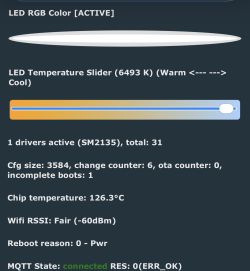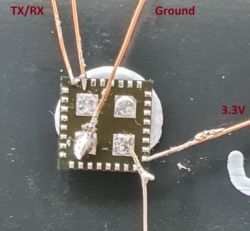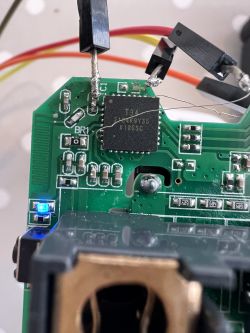Unsure if this one has been posted already.
AP-SMT-Breaker02-1CH EZB-WBZS1H16N-A - 16A Mini Smart Switch 1 Channel
Bought from the AliExpress Choice Day sales
Different to a similar mini smart switch I have flashed.
BK7231N MCU is part of the main PCB
Relay is on a daughter PCB to rotate it
Used tuya-cloudcutter to flash OpenBK (didn't even setup in SmartLife app - just went straight to cloudcutter)
> By manufacturer/device name
> Aubess
> 16A Mini Smart Switch
> 1.2.1 - BK7231N / oem_bk7231n_control_switch
OpenBK7231N_UG_1.15.597.bin
Pin settings are possibly different to other versions - these work for my device.
LED_n 6
Rel 15
Btn 8
TglChanOnTgl 14
![[BK7231N] AP-SMT-Breaker02-1CH EZB-WBZS1H16N-A - 16A Mini Smart Switch 1 Channel [BK7231N] AP-SMT-Breaker02-1CH EZB-WBZS1H16N-A - 16A Mini Smart Switch 1 Channel](https://obrazki.elektroda.pl/2081201100_1679748415_thumb.jpg)
![[BK7231N] AP-SMT-Breaker02-1CH EZB-WBZS1H16N-A - 16A Mini Smart Switch 1 Channel [BK7231N] AP-SMT-Breaker02-1CH EZB-WBZS1H16N-A - 16A Mini Smart Switch 1 Channel](https://obrazki.elektroda.pl/4107028700_1679748431_thumb.jpg)
![[BK7231N] AP-SMT-Breaker02-1CH EZB-WBZS1H16N-A - 16A Mini Smart Switch 1 Channel [BK7231N] AP-SMT-Breaker02-1CH EZB-WBZS1H16N-A - 16A Mini Smart Switch 1 Channel](https://obrazki.elektroda.pl/2460614400_1679748444_thumb.jpg)
![[BK7231N] AP-SMT-Breaker02-1CH EZB-WBZS1H16N-A - 16A Mini Smart Switch 1 Channel [BK7231N] AP-SMT-Breaker02-1CH EZB-WBZS1H16N-A - 16A Mini Smart Switch 1 Channel](https://obrazki.elektroda.pl/2575437800_1679748469_thumb.jpg)
![[BK7231N] AP-SMT-Breaker02-1CH EZB-WBZS1H16N-A - 16A Mini Smart Switch 1 Channel [BK7231N] AP-SMT-Breaker02-1CH EZB-WBZS1H16N-A - 16A Mini Smart Switch 1 Channel](https://obrazki.elektroda.pl/4827068000_1679748487_thumb.jpg)
![[BK7231N] AP-SMT-Breaker02-1CH EZB-WBZS1H16N-A - 16A Mini Smart Switch 1 Channel [BK7231N] AP-SMT-Breaker02-1CH EZB-WBZS1H16N-A - 16A Mini Smart Switch 1 Channel](https://obrazki.elektroda.pl/9530419400_1679748501_thumb.jpg)
![[BK7231N] AP-SMT-Breaker02-1CH EZB-WBZS1H16N-A - 16A Mini Smart Switch 1 Channel [BK7231N] AP-SMT-Breaker02-1CH EZB-WBZS1H16N-A - 16A Mini Smart Switch 1 Channel](https://obrazki.elektroda.pl/5821929100_1679748507_thumb.jpg)
AP-SMT-Breaker02-1CH EZB-WBZS1H16N-A - 16A Mini Smart Switch 1 Channel
Bought from the AliExpress Choice Day sales
Different to a similar mini smart switch I have flashed.
BK7231N MCU is part of the main PCB
Relay is on a daughter PCB to rotate it
Used tuya-cloudcutter to flash OpenBK (didn't even setup in SmartLife app - just went straight to cloudcutter)
> By manufacturer/device name
> Aubess
> 16A Mini Smart Switch
> 1.2.1 - BK7231N / oem_bk7231n_control_switch
OpenBK7231N_UG_1.15.597.bin
Pin settings are possibly different to other versions - these work for my device.
LED_n 6
Rel 15
Btn 8
TglChanOnTgl 14
![[BK7231N] AP-SMT-Breaker02-1CH EZB-WBZS1H16N-A - 16A Mini Smart Switch 1 Channel [BK7231N] AP-SMT-Breaker02-1CH EZB-WBZS1H16N-A - 16A Mini Smart Switch 1 Channel](https://obrazki.elektroda.pl/2081201100_1679748415_thumb.jpg)
![[BK7231N] AP-SMT-Breaker02-1CH EZB-WBZS1H16N-A - 16A Mini Smart Switch 1 Channel [BK7231N] AP-SMT-Breaker02-1CH EZB-WBZS1H16N-A - 16A Mini Smart Switch 1 Channel](https://obrazki.elektroda.pl/4107028700_1679748431_thumb.jpg)
![[BK7231N] AP-SMT-Breaker02-1CH EZB-WBZS1H16N-A - 16A Mini Smart Switch 1 Channel [BK7231N] AP-SMT-Breaker02-1CH EZB-WBZS1H16N-A - 16A Mini Smart Switch 1 Channel](https://obrazki.elektroda.pl/2460614400_1679748444_thumb.jpg)
![[BK7231N] AP-SMT-Breaker02-1CH EZB-WBZS1H16N-A - 16A Mini Smart Switch 1 Channel [BK7231N] AP-SMT-Breaker02-1CH EZB-WBZS1H16N-A - 16A Mini Smart Switch 1 Channel](https://obrazki.elektroda.pl/2575437800_1679748469_thumb.jpg)
![[BK7231N] AP-SMT-Breaker02-1CH EZB-WBZS1H16N-A - 16A Mini Smart Switch 1 Channel [BK7231N] AP-SMT-Breaker02-1CH EZB-WBZS1H16N-A - 16A Mini Smart Switch 1 Channel](https://obrazki.elektroda.pl/4827068000_1679748487_thumb.jpg)
![[BK7231N] AP-SMT-Breaker02-1CH EZB-WBZS1H16N-A - 16A Mini Smart Switch 1 Channel [BK7231N] AP-SMT-Breaker02-1CH EZB-WBZS1H16N-A - 16A Mini Smart Switch 1 Channel](https://obrazki.elektroda.pl/9530419400_1679748501_thumb.jpg)
![[BK7231N] AP-SMT-Breaker02-1CH EZB-WBZS1H16N-A - 16A Mini Smart Switch 1 Channel [BK7231N] AP-SMT-Breaker02-1CH EZB-WBZS1H16N-A - 16A Mini Smart Switch 1 Channel](https://obrazki.elektroda.pl/5821929100_1679748507_thumb.jpg)
Cool? Ranking DIY







![[BK7231N] AP-SMT-Breaker02-1CH EZB-WBZS1H16N-A - 16A Mini Smart Switch 1 Channel [BK7231N] AP-SMT-Breaker02-1CH EZB-WBZS1H16N-A - 16A Mini Smart Switch 1 Channel](https://obrazki.elektroda.pl/1767744100_1682576225_thumb.jpg)



